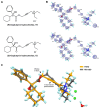This is a preprint.
An Updated Structure of Oxybutynin Hydrochloride
- PMID: 38895300
- PMCID: PMC11185708
- DOI: 10.1101/2024.06.05.597682
An Updated Structure of Oxybutynin Hydrochloride
Update in
-
An Updated Structure of Oxybutynin Hydrochloride.Adv Sci (Weinh). 2024 Oct;11(40):e2406494. doi: 10.1002/advs.202406494. Epub 2024 Sep 3. Adv Sci (Weinh). 2024. PMID: 39225443 Free PMC article.
Abstract
Oxybutynin (Ditropan), a widely distributed muscarinic antagonist for treating the overactive bladder, has been awaiting a definitive crystal structure for nearly 50 years due to the sample and technique limitations. Past reports used powder X-ray diffraction (PCRD) to shed light on the possible packing of the molecule however a 3D structure remained elusive. Here we used Microcrystal Electron Diffraction (MicroED) to successfully unveil the 3D structure of oxybutynin hydrochloride. We identify several inconsistencies between the reported PXRD analyses and the experimental structure. Using the improved model, molecular docking was applied to investigate the binding mechanism between M3 muscarinic receptor (M3R) and (R)-oxybutynin, revealing essential contacts/residues and conformational changes within the protein pocket. A possible universal conformation was proposed for M3R antagonists, which is valuable for future drug development and optimization. This study underscores the immense potential of MicroED as a complementary technique for elucidating the unknown pharmaceutical crystal structures, as well as for the protein-drug interactions.
Figures



Similar articles
-
An Updated Structure of Oxybutynin Hydrochloride.Adv Sci (Weinh). 2024 Oct;11(40):e2406494. doi: 10.1002/advs.202406494. Epub 2024 Sep 3. Adv Sci (Weinh). 2024. PMID: 39225443 Free PMC article.
-
Unraveling the Structure of Meclizine Dihydrochloride with MicroED.Adv Sci (Weinh). 2024 Feb;11(6):e2306435. doi: 10.1002/advs.202306435. Epub 2023 Dec 3. Adv Sci (Weinh). 2024. PMID: 38044280 Free PMC article.
-
Distinct Conformations of Mirabegron Determined by MicroED.Adv Sci (Weinh). 2023 Dec;10(34):e2304476. doi: 10.1002/advs.202304476. Epub 2023 Oct 17. Adv Sci (Weinh). 2023. PMID: 37847906 Free PMC article.
-
MicroED for the study of protein-ligand interactions and the potential for drug discovery.Nat Rev Chem. 2021 Dec;5(12):853-858. doi: 10.1038/s41570-021-00332-y. Epub 2021 Oct 27. Nat Rev Chem. 2021. PMID: 37117388 Review.
-
Macromolecular crystallography using microcrystal electron diffraction.Acta Crystallogr D Struct Biol. 2021 Mar 1;77(Pt 3):313-324. doi: 10.1107/S2059798320016368. Epub 2021 Feb 17. Acta Crystallogr D Struct Biol. 2021. PMID: 33645535 Free PMC article. Review.
References
-
- Chapple C. R. Muscarinic receptor antagonists in the treatment of overactive bladder. BJU International 2000, 85 (S3), 33–46. - PubMed
-
- Michel M. C.; Hegde S. S. Treatment of the overactive bladder syndrome with muscarinic receptor antagonists-a matter of metabolites? Naunyn-Schmiedeberg’s archives of pharmacology 2006, 374, 79–85. - PubMed
-
- Takasu T.; Ukai M.; Sato S.; Matsui T.; Nagase I.; Maruyama T.; Sasamata M.; Miyata K.; Uchida H.; Yamaguchi O. Effect of (R)-2-(2-aminothiazol-4-yl)-4’-{2-[(2-hydroxy-2-phenylethyl) amino] ethyl} acetanilide (YM178), a novel selective β3-adrenoceptor agonist, on bladder function. Journal of Pharmacology and Experimental Therapeutics 2007, 321 (2), 642–647. - PubMed
Publication types
Grants and funding
LinkOut - more resources
Full Text Sources
Miscellaneous
